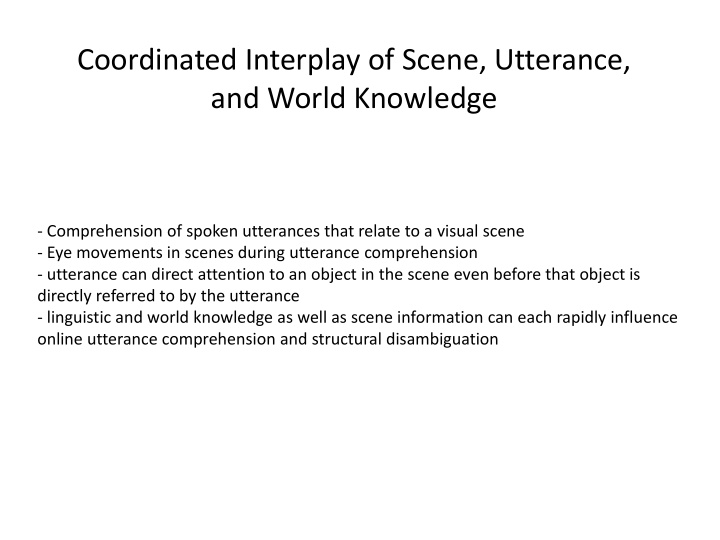



Coordinated Interplay of Scene, Utterance, and World Knowledge - Comprehension of spoken utterances that relate to a visual scene - Eye movements in scenes during utterance comprehension - utterance can direct attention to an object in the scene even before that object is directly referred to by the utterance - linguistic and world knowledge as well as scene information can each rapidly influence online utterance comprehension and structural disambiguation
Experiment :Precise time-course with which scene information informs online utterance comprehension and disambiguation as a function of when the utterance identifies that scene information as relevant for comprehension Important immediately depicted events are relative to world knowledge about plausible role fillers for incremental thematic interpretation
Put the apple on the towel in the box, the phrase on the towel can be temporarily analyzed as a modifier of the first noun phrase. In a context containing one apple on a towel (location) and an empty towel (destination), people inspected the apple when hearing Put the apple. Having heard on the towel, listeners mostly fixated the empty towel, suggesting interpretation of the ambiguous phrase as destination. How does scene information influences structuring and interpretation of the utterance in a manner closely time-locked to, or independently of, when the utterance identifies that scene information as relevant.
Experiment1: MV/RR ambiguity Example sentences: The ballerina splashed the cellist. (1) The ballerina sketched by the fencer splashed the cellist. (2) Examples (1) and (2) are ambiguous up to the second argument.
Procedure - For each trial, the image appears 1,000 msec before utterance onset. - Prior to the experiment, participants are instructed to listen to the sentences and to inspect the images, and to try to understand both sentences and depicted scenes.
In Example (1), the initial noun phrase is the agent of the subsequent verb (main clause). In Example (2), the initial noun phrase is the patient of the verb of the RR clause ( sketched by the fencer ), and the agent of the main clause ( splashed the cellist ).
Experiment 2: Authors propose that scene information has a stronger influence on adult language comprehension when identified as relevant by concrete rather than abstract terms. If this were the case, then we would expect a weaker or less tightly coordinated utterance-mediated influence of depicted events for Experiment 2 Example sentences: The ballerina will splash the cellist. (3) The ballerina being sketched by the fencer splashed the cellist. (3) Will- bias towards active future, shows ballerina as agent Being- bias towards passive event, shows ballerina as patient the only information type that was available for early thematic role assignment and structural disambiguation, hence no stereotypical bias present
References -Pia Knoeferle, Matthew W. Crocker: The Coordinated Interplay of Scene, Utterance, and World Knowledge: Evidence From Eye Tracking -Paola Merlo, Suzanne Stevenson: Language Acquisition and Ambiguity Resolution: The role of Frequency Distributions - Michael K. Tanenhaus James S. Magnuson, Delphine Dahan, and Craig Chambers: Eye Movements and Lexical Access in Spoken-Language Comprehension: Evaluating a Linking Hypothesis between Fixations and Linguistic Processing
Recommend
More recommend